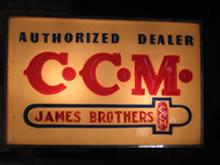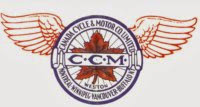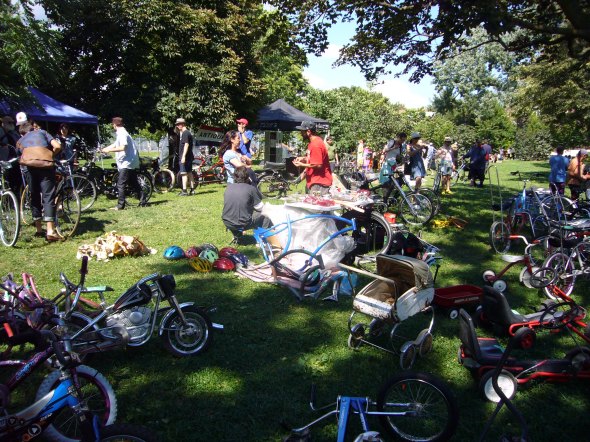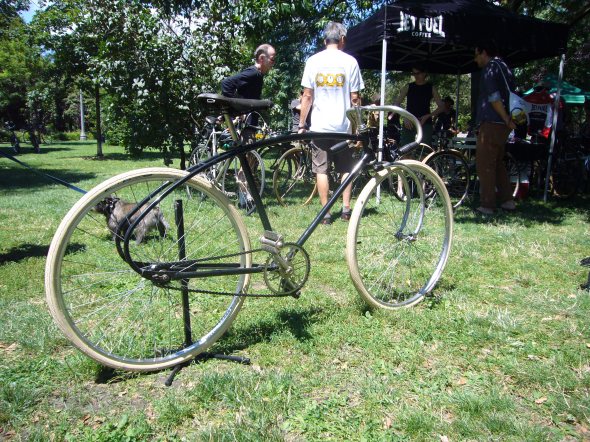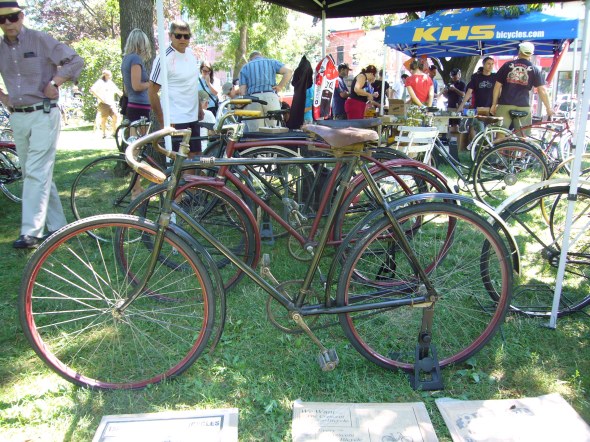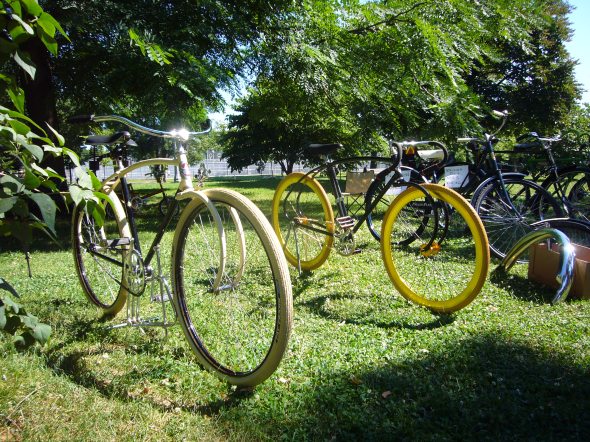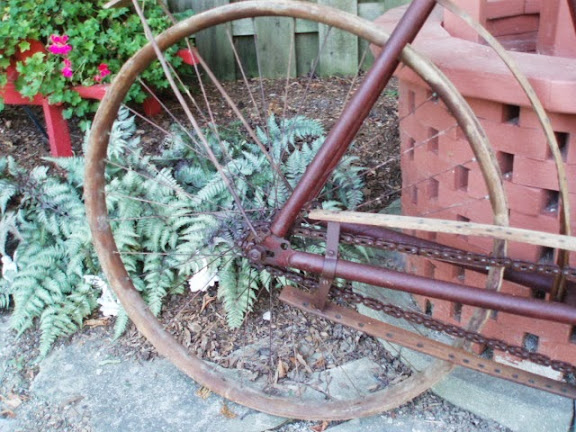Archives
A while back noted CCM bicycle collector Ken Martin received a bike from an acquaintance of his by the name of Dan. According to Ken this is how it happened:
Dan, an incurable collector of all things with wheels, was out riding his bike when he came upon a van with an open trailer full of scrap metal about to pull out on the road from his driveway heading for the landfill. He stopped the vehicle and asked if he could have the severely rusting bike that was on top. "Sure take it" the driver said. Dan went back and got his pickup truck and took it home. This bike had already met its end, now a more permanent one was just minutes away, only fate had other plans. Here is a picture of that very bike.
This was that rusting heap CCM Motorbike snatched from the jaws of fate now three weeks later reborn and ready for its second life and somehow fitting that it was reclothed in red, symbolic of its warrior past and its determination to live!
I now own this bike.
When Dan restored this bike, he refused to remove the headbadge, instead taped over it and painted around it. I asked him why he did this and he seemed shocked I would even ask. "This is the bike's identity, to remove it is a sign of disrespect," said Dan.
Ummmm........OK. He is eccentric, but in a good way.
Ken Martin
Have a bike (or bikes) with a story to tell send it along and we'll share it with everyone - john.mckenty@sympatico.ca
John
For the third part in this series, I thought it might be interesting to find out what happened to CCM bicycles after the company was purchased by Procycle in 1983. To that end, I contacted Raymond Dutil, founder and CEO of Procycle, who agreed to answer my questions by email. Although he has told me that the negotiations that led to his takeover of CCM could fill a book, in and of themselves, you will see that Mr. Dutil is, for the most part, a man of a few words. What follows is a transcript of my interview with him. Regards, John
- Me: When Procycle began in 1977 was it a bicycle manufacturer from the outset?
- Mr. Dutil: Yes
- Me: Did Procycle’s purchase of CCM in 1983 include the factory in Weston?
- Mr. Dutil: No
- Me: What happened to the inventory of parts and bicycles on hand at the time.
- Mr. Dutil: Transferred to Procycle St-Georges, Beauce, Québec
- Me: How soon after its purchase of CCM did Procycle begin to manufacture CCM bicycles?
- Mr. Dutil: 2 years after
- Me: What set the CCM line apart from the other lines of bicycles being produced by Procycle?
- Mr. Dutil: We started to offer only to IBD. After we went to mass merchant.
- Me: Was the CCM line always manufactured in Canada?
- Mr. Dutil: Up to 2004 Yes
- Me: When and why did Procycle cease production of the CCM bicycle line?
- Mr. Dutil: USD/CAD
- Me: When did Procycle sell the rights for the CCM bicycle line to Reebok?
- Mr. Dutil: 2006
- Me: Do you know when those rights were transferred to Canadian Tire?
- Mr. Dutil: No
- Me: The making of bicycles in Canada has always been a difficult proposition. What were/are its greatest challenges?
- Mr. Dutil: Easy access to Asian producers

2014 Vintage CCM Calendar
Send a photo of your favourite pre-1983 CCM bike(s) currently in your possession to john.mckenty@sympatico.ca and we will use them to produce a professional 2014 calendar.
Photos should be sharp, clear and free of clutter. No people in them.
We will need 14 photos - one for each month and one for the front and back cover.
Depending on the number of photos submitted, not all may be used.
Photos should be sent by the end of August in order to have the calendars available in the fall.
Along with the photos, please include a few brief details about the bike - year, model, personal history etc.
We will produce a limited number of calendars so when they're gone, they're gone.

|
|
| |
|
| ||
|
THIS WEEKEND! (Fri Aug 9th to Sunday August 11th) What to bring:
When and Where: Friday August 9th - 9:30am to 9:00pm Billings Bridge Centre * Bicycles for Humanity volunteers will be on site on Saturday August 10th between 10am and 1pm to greet donors and provide information the initiative | ||
|
This year, we will be shipping a Bicycle Empowerment Centre (BEC) - a 40ft shipping container packed with 400 donated bicycles, spare parts and tools, converted into a bike shop on site - to Kibera, Kenya to benefit an orphan care organization. Through a partnership with Wheels of Africa, B4H will establish the BEC to help empower and engage a community in creating sustainable and responsible economic development in Kenya, while enabling greater mobility in the area for students, workers, and healthcare volunteers. We are so very grateful for the enthusiastic support from the many individuals and organizations who donate funds, goods, facilities and services and to the volunteers who give their time and energy towards helping improve lives! THANK YOU!
To date Vintage CCM has donated $1,000 to the Ottawa chapter of Bicycles For Humanity based on sales of Canada Cycle & Motor: The CCM Story. Thanks to all who have ordered the book and by so doing contributed to this very worthy cause.
| ||
Photos from the 2013 Canadian Vintage Bicycle Show held on Sunday, June 23
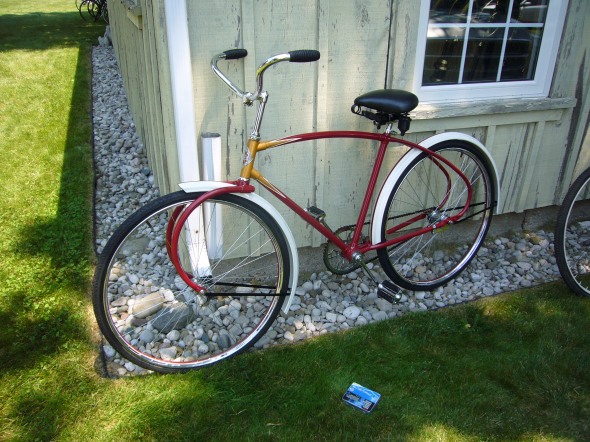
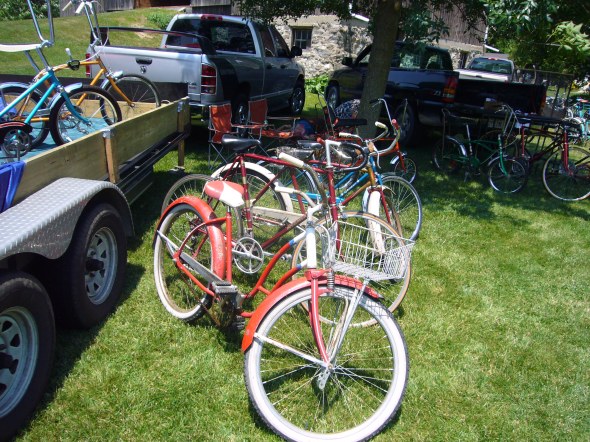
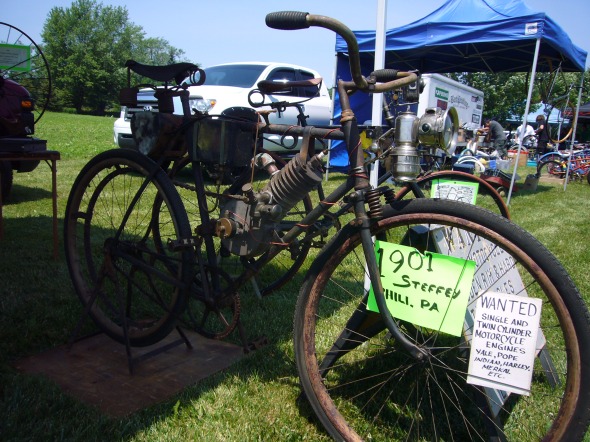
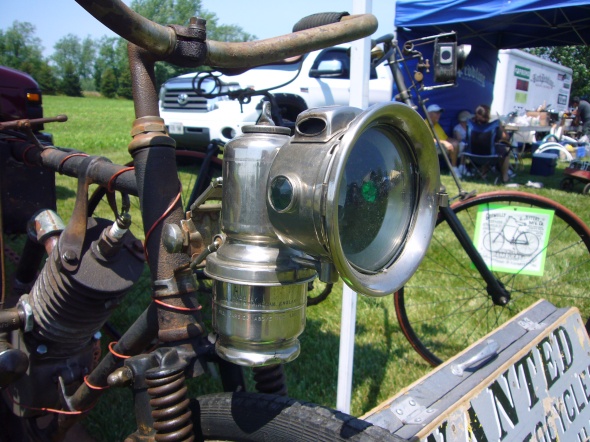
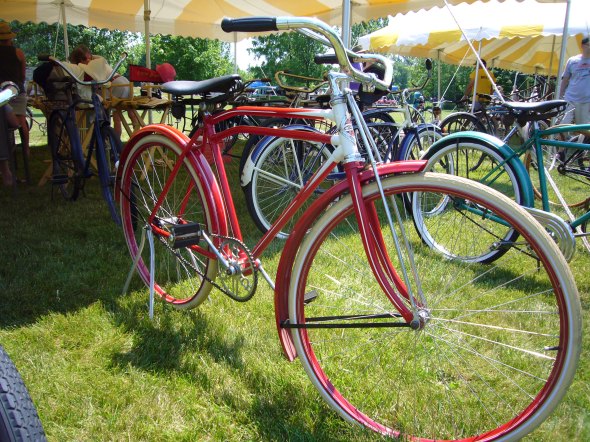
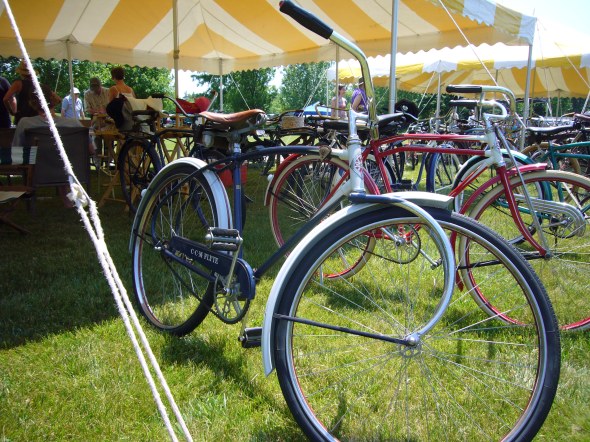
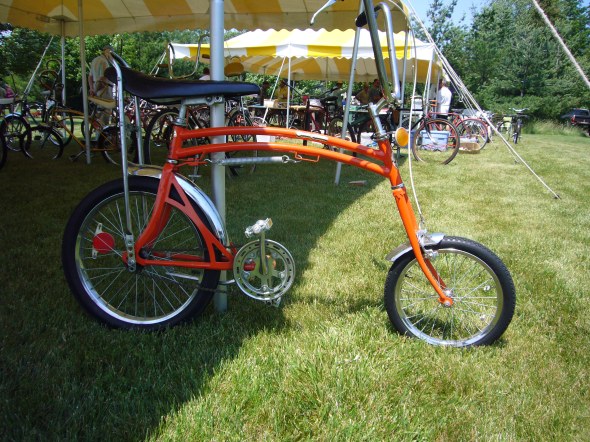
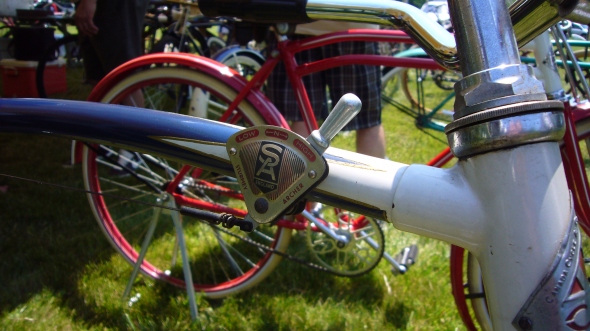
The above photos are courtesy of Greg Chown.
Be sure to visit Greg at his blog Three Speed Mania.
Greg is also a key organizer for an upcoming event - that being the 2013 edition of the Toronto Vintage Bicycle Show to be held on Sunday July 28. More details here.

'Bumper crop' of vintage bikes

Jamie McGregor, organizer of the annual Vintage Bicycle Show on Sunday at Heritage View Farm on Tutela Heights Road, shows a 1904 Brantford Red Bird 57 Special shaft-drive bicycle. The shaft-drive design had women in mind, so their long dresses would not get caught or soiled in a chain. They were made for only a few years, mainly because the bicycle had no brakes. (Brian Thompson, The Expositor)
Or maybe even their parents' youth.
"You'll find what you're looking for right over there," McGregor quickly said Sunday under the bright hot sunshine over Heritage View Farm on Tutela Heights Road across from the Bell Homestead.
He was talking to a man who was looking for CCM model children's bikes.
McGregor simultaneously held in handshake the extended hand of a man who had greeted him warmly, directed him to a group of bikes, where he was sure to find what he was looking for, then patted him on the shoulder.
It was probably the 20th questioning visitor to grip his hand in the last 10 minutes.
"This is a bumper year and we have a bumper crop," McGregor said as the man headed on his way.
"It's nice seeing the diversity we have today," he said of the mix of Canadian and American bicycles, and the enduring popularity of the CCM ( Canadian Cycle and Motor Ltd.) brands.
What was his best vintage model to show?
We walked over to a Brantford Red Bird 57 Special from 1904. It was parked on a bike display ramp bearing all the merchandising display emblems from the time.
The bicycle had a shaft rather than a chain for pedalling.
"That makes it rare," said McGregor.
Among the multitude of wheels were Victorian Penny Farthings, as well as "muscle" bikes and banana bikes from the 1960s, and racing models from most decades.
McGregor pointed to a group of BMX bikes.
The event also had displays that showed the impact of its own age over time.
The BMX brand name was introduced in the early 1970s when kids began racing their bicycles on dirt tracks in southern California. It was their way of aping motocross stars.
"You wouldn't notice it, but they're starting to get old," McGregor mused.
"I guess it means we're getting older, too."
Veteran attendees have identified the show as a place where they're likely to find the parts they need for their handyman projects.
Admittance to the show was a $5 donation to the Stedman Community Hospice and donations for food and drink.
For years, McGregor has used the show as a hospice fundraiser after the facility provided end-of-life care to his father, John, who died there six years ago.
As the current NHL season winds its way to a slow and some would say painful close (I mean c'mon hockey in June), it's perhaps a good time to reflect upon the first world champions of hockey - the CCM Canadas.
By 1930 there were sufficient countries playing hockey for the International Ice Hockey federation to stage its first world championship tournament independent of the Olympics. The games were to take place in Chamonix, France and for the first time ever in a major competition, a team from outside North America or Europe would take part with Japan entering a team in the competition.
Canada's entry at the tournament was to be an industrial league team belonging to the Canada Cycle & Motor Co. of Weston, Ontario. In 1929 the CCM team had not only won the Toronto Mercantile title, but had also defeated the winner of the city's Mining and Brokers League.
That fall when company official George Braden travelled to Europe, he decided that overseas hockey players would benefit from increased exposure to Canadian hockey, not to mention Canadian hockey equipment. As export manager for CCM, Braden, no doubt, saw before him a lucrative new market for the company's merchandise.
When Braden obtained permission from the Canadian Amateur Hockey Association to send the CCM team on a European tour, it was decided that the company team would also represent the country at the newly-formed world championships in Chamonix.
So it was that on Dec. 5, 1929, the CCM team, along with Braden and coach Les Grant, gathered at Toronto’s Union Station to catch the train to Saint John, New Brunswick. From here they set sail the following day eventually arriving in London on Dec.14th. Wearing red sweaters with a large white maple leaf and the name "Canadas" prominently displayed across them, the team averaged a game every second night, scoring victory after victory en route to the world championships scheduled to begin on Jan. 27, 1930.

Unfortunately when warm weather at the outdoor venue in Chamonix pushed the start of the final games back four days, the round-robin system was abandoned for a knock-out format and the Canadian team was given a bye directly into the finals.
To stay in shape while awaiting the final game the Canadas scheduled games in Vienna, Austria. During a stretch of three games in three nights, the team dropped a 1-0 decision to the Austrian national team. It was the first Canadian loss in twenty-five games, with the game being played in a heavy downpour of rain. The Canadas bounced back the next night with a 6-0 win over the Vienna Skating Club.
By now the weather had forced the final games of the tournament to be moved to Berlin where the Canadas were scheduled to play the European champion team from Germany in the final game. Spurred on by the hometown crowd, the German team took an early lead, but the Canadas stormed back for a decisive 6-1 victory with Gordie Grant and Alec Park each scoring a pair of goals.

Having won the world championship, the CCM team arrived back in Toronto on the evening of Feb. 25, 1930. Since leaving town the CCM squad had travelled 22,500 kilometres, won thirty-one games and outscored their opponents 304 – 26.

